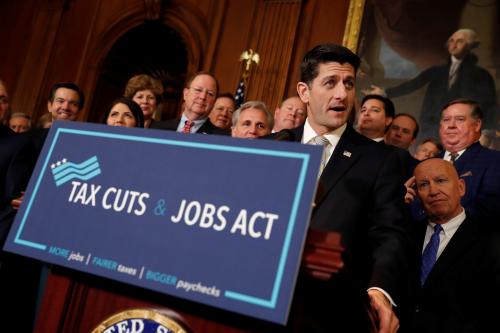Ever since Rep. Alexandria Ocasio-Cortez, the new congresswoman from New York, advocated marginal tax rates “as high as 60 or 70 percent”, critics have assailed the idea as “confiscatory”, “total fantasy”, economically disastrous, and unlikely to raise much tax revenue.
At Davos, Michael Dell, chief executive of Dell Computer: “Name a country where that’s worked.”
How about America under the Tax Cuts and Jobs Act? It’s not widely understood, but in their 2017 tax bill, Republicans imposed top tax rate that can reach 60 to 70 percent on high-income corporate executives. This new higher tax rate in the 2017 tax bill probably hits more taxpayers than AOC’s top rate would. It’s expected to raise billions of dollars over the next decade. And it was justified as necessary to pay for a top political priority: a lower corporate tax rate. I don’t remember much public outcry then. Cutting through the hypocrisy and hyperbole, whether to impose high tax rates on certain taxpayers isn’t a question of economic or political feasibility—we do it now—it’s about differing judgments over who should pay more in taxes and why.
The Republican tax reform in 2017 made two changes that jacked up top rates on high earners. First, the Tax Cuts and Jobs Act surreptitiously applied the full 21 percent corporate rate to the compensation of certain highly paid officers and employees of publicly traded companies and to specified tax-exempt organizations. The new rules (primarily in Section 162(m) of the tax code) eliminate the ability of corporations to deduct compensation in excess of $1 million for each affected employee and imposes an equivalent 21 percent “excise tax” on similar employees at tax-exempt organizations.[1] Executive pay is not just subject to federal individual income and payroll taxes, it’s now subject to the corporate tax as well.
But that’s not all. Since many states follow federal corporate tax conventions, state corporate rates will also apply to executive pay. And, the TCJA also eliminated the deductibility of state and local taxes for individuals individual level above $10,000. That means higher-income taxpayers in states like California and New York City will pay an additional 13 percentage points on top of federal rates—several percentage points higher than prior to the reform.
To be concrete, paying a corporate officer of a publicly traded New York company an extra $1 million will result in an additional $261,350 in federal and state corporate taxes, $370,000 in federal individual income tax, $38,000 in payroll tax, and $127,000 in New York State and New York City tax.
Comparing the $796,350 in taxes to the $1.26 million in pre-tax income yields a marginal tax rate of 63 percent. The mini marginal federal rate that applies in states without income taxes is 51 percent.
Billionaire CEOs in Davos concerned about the dire consequences of a 60 to 70 percent tax rate should consult their accountants.
Billionaire CEOs in Davos concerned about the dire consequences of a 60 to 70 percent tax rate should consult their accountants.
Will anyone pay this tax? The evidence thus far is yes. A surprising share of companies already paid some tax under the old, easily avoided regime that exempted executive pay from the tax provided that it was “incentive based.” But in response to the new rules Netflix, for example, announced that it was eliminating its “incentive-based” bonuses and replacing them with increases in salaries. If CEO Reed Hastings is paid $26 million this year, as he was in 2017, as much as $19 million in taxes would apply to the amount over $1 million in total U.S. and California taxes. That’s $6 million more than before.
Like payroll taxes and income taxes, which are nominally withheld and paid by a company on behalf of the employee, the new tax targeted at executive pay is eventually likely to be borne by those executives. And, like taxes on wage income in general, the tax will be difficult to avoid because it is reported to tax authorities by the corporation, and there are stricter limits on the ability to defer or avoid tax for employees than there are for business owners. The income can’t be shifted to the Caymans, won’t all fit in a 401(k), and even giving cash to charities can’t reduce your taxable income by more than 60 percent.
Indeed, according to the Joint Committee on Taxation, the new rules for corporate officers will raise about $1 billion per year—a significant amount given there are now about 3,600 public companies, the tax applies to a maximum of five employees per firm, and only to compensation in excess of $1 million. Perhaps 18,000 employees, not including non-profit executives—but still more than the 16,000 individuals that would be subject to an AOC-style tax bracket that applied starting at $10 million.
The corresponding tax on non-profit executives is expected to raise another $200 million annually. In countless appraisals of the TCJA’s likely economic effects from think tanks, the JCT, and the bill’s sponsors, few expressed concern about confiscatory rates or impending economic drag.
Is a 70 percent rate a good idea? That’s a harder question that depends on your view of the value and appropriate size of government programs, from whom and how much should the tax system redistribute income, and the costs in forgone economic activity that results from higher rates. But is it economically feasible, politically viable, and revenue raising? Of course, we’re doing it now.
[1] For certain health insurance executives, the tax kicks in at $500,000 in earnings.





Commentary
Ocasio-Cortez wants to raise the tax rate on high earners. The Tax Cuts and Jobs Act already did
January 29, 2019